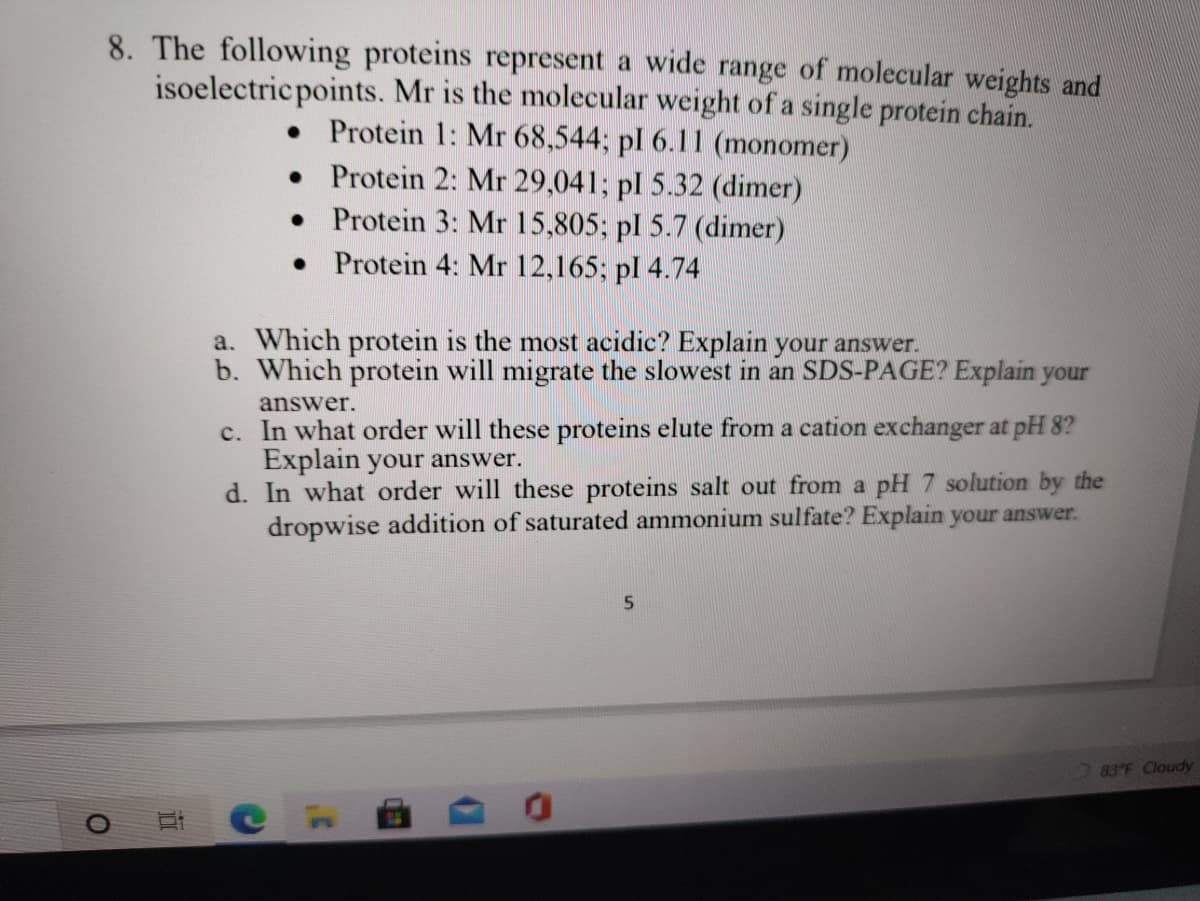8. The following proteins represent a wide range of molecular weights and isoelectric points. Mr is the molecular weight of a single protein chain. • Protein 1: Mr 68,544; pl 6.11 (monomer) • Protein 2: Mr 29,041; pl 5.32 (dimer) • Protein 3: Mr 15,805; pl 5.7 (dimer) • Protein 4: Mr 12,165; pl 4.74 a. Which protein is the most acidic? Explain your answer. b. Which protein will migrate the slowest in an SDS-PAGE? Explain your answer. c. In what order will these proteins elute from a cation exchanger at pH 8? Explain your answer. d. In what order will these proteins salt out from a pH 7 solution by the dropwise addition of saturated ammonium sulfate? Explain your answer.
8. The following proteins represent a wide range of molecular weights and isoelectric points. Mr is the molecular weight of a single protein chain. • Protein 1: Mr 68,544; pl 6.11 (monomer) • Protein 2: Mr 29,041; pl 5.32 (dimer) • Protein 3: Mr 15,805; pl 5.7 (dimer) • Protein 4: Mr 12,165; pl 4.74 a. Which protein is the most acidic? Explain your answer. b. Which protein will migrate the slowest in an SDS-PAGE? Explain your answer. c. In what order will these proteins elute from a cation exchanger at pH 8? Explain your answer. d. In what order will these proteins salt out from a pH 7 solution by the dropwise addition of saturated ammonium sulfate? Explain your answer.
Organic Chemistry
8th Edition
ISBN:9781305580350
Author:William H. Brown, Brent L. Iverson, Eric Anslyn, Christopher S. Foote
Publisher:William H. Brown, Brent L. Iverson, Eric Anslyn, Christopher S. Foote
Chapter3: Stereoisomerism And Chirality
Section3.8: The Significance Of Chirality In The Biological World
Problem EQ: As stated, proteins are stereochemically pure because only a single enantiomer of each amino acid...
Related questions
Question

Transcribed Image Text:8. The following proteins represent a wide range of molecular weights and
isoelectric points. Mr is the molecular weight of a single protein chain.
• Protein 1: Mr 68,544; pl 6.11 (monomer)
• Protein 2: Mr 29,041; pl 5.32 (dimer)
• Protein 3: Mr 15,805; pl 5.7 (dimer)
• Protein 4: Mr 12,165; pl 4.74
a. Which protein is the most acidic? Explain your answer.
b. Which protein will migrate the slowest in an SDS-PAGE? Explain your
answer.
c. In what order will these proteins elute from a cation exchanger at pH 8?
Explain your answer.
d. In what order will these proteins salt out from a pH 7 solution by the
dropwise addition of saturated ammonium sulfate? Explain your answer.
5
83°F Cloudy
Expert Solution
This question has been solved!
Explore an expertly crafted, step-by-step solution for a thorough understanding of key concepts.
This is a popular solution!
Trending now
This is a popular solution!
Step by step
Solved in 4 steps with 4 images

Recommended textbooks for you

Organic Chemistry
Chemistry
ISBN:
9781305580350
Author:
William H. Brown, Brent L. Iverson, Eric Anslyn, Christopher S. Foote
Publisher:
Cengage Learning

Organic And Biological Chemistry
Chemistry
ISBN:
9781305081079
Author:
STOKER, H. Stephen (howard Stephen)
Publisher:
Cengage Learning,

General, Organic, and Biological Chemistry
Chemistry
ISBN:
9781285853918
Author:
H. Stephen Stoker
Publisher:
Cengage Learning

Organic Chemistry
Chemistry
ISBN:
9781305580350
Author:
William H. Brown, Brent L. Iverson, Eric Anslyn, Christopher S. Foote
Publisher:
Cengage Learning

Organic And Biological Chemistry
Chemistry
ISBN:
9781305081079
Author:
STOKER, H. Stephen (howard Stephen)
Publisher:
Cengage Learning,

General, Organic, and Biological Chemistry
Chemistry
ISBN:
9781285853918
Author:
H. Stephen Stoker
Publisher:
Cengage Learning

Introduction to General, Organic and Biochemistry
Chemistry
ISBN:
9781285869759
Author:
Frederick A. Bettelheim, William H. Brown, Mary K. Campbell, Shawn O. Farrell, Omar Torres
Publisher:
Cengage Learning


Introductory Chemistry: A Foundation
Chemistry
ISBN:
9781337399425
Author:
Steven S. Zumdahl, Donald J. DeCoste
Publisher:
Cengage Learning